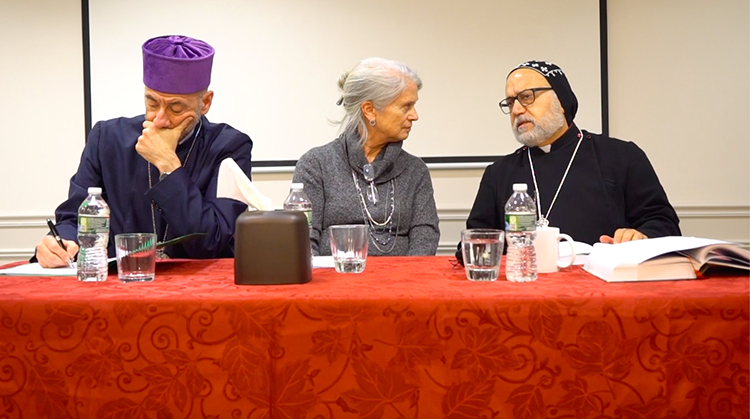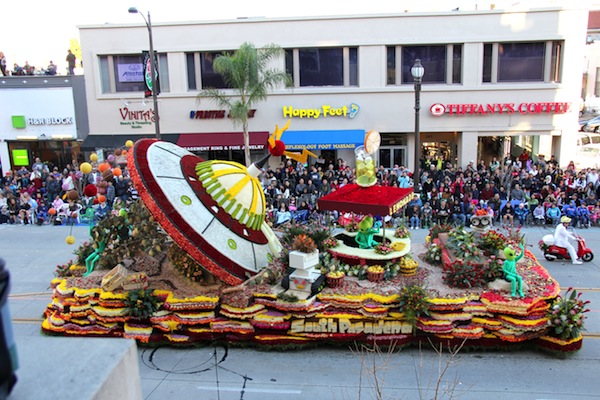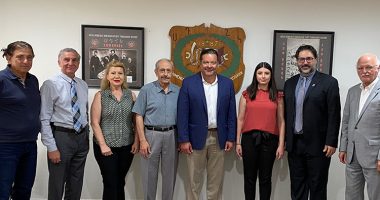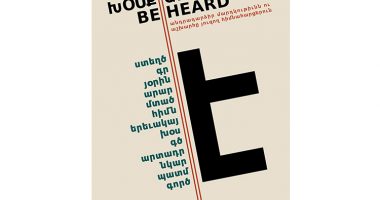BY FLORENCE AVAKIAN
MOR APHREM CENTER, NJ—–What is monasticism. What was it like in ancient times. Can it survive in our current world?
This was the tantalizing subject of a recent Diocesan Zohrab Information Center lecture held at the Mor Aphrem (St. Aphrem) Center of the Eastern U.S. Syriac Orthodox Archdiocese in Paramus, NJ.
The speakers included the hierarchs of the Armenian and Syriac Dioceses of Eastern America, Archbishop Mor Dionysius John Kawak, Patriarchal Vicar and Primate of the Archdiocese for the Syriac Orthodox Church for the Eastern USA, and Bishop Daniel Findikyan, Primate of the Diocese of the Armenian Church of America (Eastern); and Dr. Roberta Ervine, Professor of Armenian Christian Studies at St. Nersess Armenian Seminary.
Also addressing the attendees were the Very Rev. Fr. Augeen Alkhouri, a monk of the Syriac Orthodox Church who resides at the Mor Aphrem Center, and Deacon Eric Vozzy, Resource Developer of the Eastern Diocese’s Department of Creative Ministries.
The history of monasticism in the two sister churches, the current state of monasteries, and the potential future for monastic life in America were the main topics of the discussion.
Enthusiastically welcoming the audience, Dr. Christopher Sheklian, Zohrab Information Center Executive Director, briefly introduced the discussion, a culmination of a season-long Zohrab Information Center series on “monasticism”. He described both the lecture series and the panel discussion as an “exploration of what monasticism has been and how it could exist in our 21st century.”
Archbishop John Kawak began his discourse on a warm personal note, recalling his education and friendship with Bishop Findikyan in Rome when both were deacons. “It was the hand of God that made us the heads of our churches in the Eastern United States,” Bishop Daniel interjected to loud applause.
BEGINNING IN 4TH CENTURY IN SYRIA
Starting in the 4th century, many famous monasteries were founded under the See of Antioch in Syria, and Mesopotamia. They became centers of prayer, research, learning and the virtuous life with thousands of monks and nuns. “The fragrance of their virtue wafted gloriously from their monasteries, caves, hermitages and cells,” the Syriac Archbishop stated poetically.
“In hard times, the authorities abandoned their cells and monasteries and went into the cities to aid the faithful, and to confirm them in their religion. When heresy arose, they departed to preach to the faithful, to preserve them from the mistaken beliefs of the heretics, and to give them a firm hold in the orthodox faith.”
Some of these famous monasteries from the 4th century on were mainly found in Syria, Turkey, Egypt, Palestine and Jerusalem. One of the most famous, was St. Matthew’s Monastery founded in the late 4th century, with a large population of monks, and still inhabited today, Archbishop Kawak related.
DEEP ROOTS
In his talk, Bishop Daniel revealed that there were also deep roots of monastic life in, and outside of Armenia. “Monasteries were truly engines of the Armenian Church. It was in the monasteries within Armenia that the creators of our theology trained future priests and nuns. All phases of art are expressions of faith. They were driven in the monasteries, and spearheaded by monks.”
“Most Armenian up to 120 years ago lived in walking distance of monasteries,” continued the Diocesan Primate. What interrupted that was the Genocide. The Ottoman regime taxed these monasteries out of existence.
“Today the hierarchical centers of our church in Holy Etchmiadzin, Antelias, Jerusalem and Constantinople have preserved various facets of our church’s traditional monastic life. But that is still a far cry from the spiritual and creative dynamism of past centuries.”
Emphasizing a significant point, the Primate asked “how can the Armenian Church thrive or even survive without monasteries today. What will drive our church without monks. We should have a revived sense of monastic life, not like in the past, but in today’s environment, offering us a profound sense of inspiration,” Bishop Daniel stated with conviction.
Professor Roberta Ervine recalled that 12th St. Nerses Shnorhali told the Armenian monks that the monastic life should “infiltrate” the world. Without it, chaos will reign. “Monks are the adventurers of the spiritual life. This life changed through the centuries because the community has changed. A monastery is symbiotic with its community.”
CRUCIALLY NECESSARY
What is crucially needed today, Professor Ervine stressed are the elements of education, healing, service, hospitality, the preservation of culture, and the offering of alternatives. All of these should be combined in the life of the monk, and with individual married priests.
“We live in a world of fragility. Why not give service. Why not allow that of a monastic situation. There should be a bridge between our past and our future here,” Professor Ervine said.
Deacon Eric Vozzy shared his thoughts and experiences, by confessing that he has always been “drawn” to the concept of monasticism. This was a major pull in his return to the Orthodox Christianity, noting that the minimal presence of monastic life in the Armenian Church today is a “void.”
“We need it because for me it would result in an integrated life,” he said with obvious emotion. He wondered “how many lives could of or would have looked different” if there was a monastery here in America for others like him drawn to monastic life. He added that it would be “refreshing,” and enhance the “spiritual life of the church.”
He referenced conversations throughout Christendom about how difficult it is for a Christian to live an authentic Christian life in today’s society. While a monastery might address these concerns, he asked about the challenges of being a monk and running a monastery in America today, including questions of “location, logistics, rubrics, prayer schedules and the responsibility of the communities.” “If monasticism is so vital, how much longer do we have to delay?” he asked. “The Armenian Church has the responsibility to allow the opportunity and room for monasticism to flourish.
Also speaking was the Very Rev. Fr. Augeen Alkhouri, a young monk of the Syriac Church who described his daily routine which involves prayer, research, service, and activities with the youth of the church. “Being a monk has enriched my life to such a tremendous extent,” he said, his glowing face testifying to his words.
During the lively question and answer period, several significant points emerged, including the difference between celibacy (no sexual relations) and monasticism, the psychological problems of celibates living alone, and the possible lack of understanding of people’s problems by celibate priests.
All agreed that the evening’s creative ideas should hopefully lead to vibrant conversations. Emphasized was the crucial link that must be pursued between education and monasticism, and how the present Christian life should melt in with the Western way of life.










